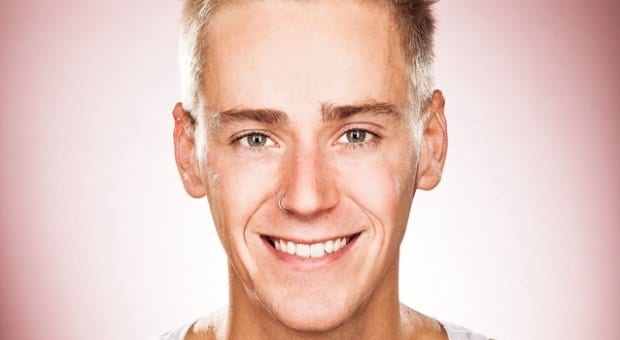The first bubble of shiny raised skin emerges the moment the translucent hyaluronic acid jelly flows into Peter Breeze’s face.
As Dr Stephen Peach depresses the plunger on the quivering hypodermic needle, Breeze’s left cheek grows a spot of ripe plumpness. Best of all, a few of the tiny wrinkles in Breeze’s 27-year-old skin are swallowed up. Mission accomplished.
“Yay!” Breeze says.
In cosmetic medicine, this procedure is called a “soft lift.” It combines two of the mildest, least invasive, most popular cosmetic procedures: Botox and dermal fillers. Together, the two offer a temporary, low-risk cosmetic pick-me-up that takes only an afternoon at the spa and around $1,000. Perfect for the targeted middle-aged woman with a moderate pocketbook and no desire to look like Joan Rivers.
But Breeze is neither middle-aged nor a woman. A man under 30, he represents a fraction of one percent of the Botox demographic.
The young gay musician, performer and tireless self-promoter believes that can change.
“It’s always been something that’s been talked about, but it has to become accessible,” he says. “People need to get it out of their minds that it’s not fucking plastic surgery.”
Breeze thinks the young gay crowd is a ripe target market for Botox and dermal fillers.
“Spending 10 years in the club is going to have an effect on your body, physically,” he says. “I think the reason it’s appealing to people in that lifestyle is that they can freshen up. It’s almost like you take back the years of being all crazy.”
Full disclosure: Breeze is actively promoting cosmetic medicine. He approached Xtra to write this story, and his cross-promotion deal with Phresh Spa means he gets the procedure done free. Breeze is Phresh’s new public face to the gay community.
But Breeze also has some personal skin in the game. The deep laugh lines around his mouth have bothered him much of his life. Now, he hopes, an injection of dermal fillers will make them go away.
When Breeze burst onto the music scene in 2007, he was a wiry, blond whip of hard-partying charisma. Since then he has aged, cooled and wrestled with the insecurity that drove him to the spotlight.
“I think when you really get down to it, nobody desires love from the whole world unless they’re trying to fill some kind of void in their lives,” he says. “Everyone has their insecurities, and I think by talking about it openly it actually makes you look like a stronger person.”
***
Once Peach has injected enough filler to raise Breeze’s cheekbones slightly, he places one gloved finger inside Breeze’s mouth and massages the lump into a smooth contour. After 48 hours, the gel will set in place.
Next, Peach tackles the laugh lines. He uses a pinky-length diabetic syringe to slide a 10th of a millilitre of fluid under the thinnest layer of Breeze’s skin to soften out the creases.
The Botox shots are simple. Nine tiny injections around the eyes, and it is all over. Unlike the filler, the Botox will not take effect for a few days.
Each bottle of dermal filler costs about $500, while the Botox costs $10 per shot. All together, Breeze’s treatment would cost around $1,200. The Botox will wear off after six months, while the dermal fillers will slowly metabolize into Breeze’s body in the next year.
Peach believes in what he does; his rock-star smile and smooth skin show he has sampled his own wares. Peach is also a general practitioner and passionately defends the medical value of his work.
“You have to realize, when people feel a little better about themselves, it can mean a huge difference in their lives,” he says. “It can mean the difference between feeling better in a relationship, feeling better in a social or occupational way, as well. All of a sudden you feel better in your workplace, so you’re a more productive worker… There’s nothing superficial about that.”
***
At 25 years old, London Savant lay in a hospital bed, blood pouring from his face, and wondered if his nose job was going to kill him.
He had dislodged a scab inside his nose while swimming, just weeks after surgery. The doctors told him he would need a transfusion.
“Oh god,” he thought. “It would be so retarded if I died from blood loss because I had cosmetic surgery because I’m vain.”
Savant was fine, of course, but the accusation of vanity is harder to escape. One of Savant’s close friends still will not talk to him about his nose job or his Botox. She told him that augmenting his appearance was wrong.
“I didn’t really care what other people thought,” Savant says. “It was something I wanted, so I thought, I’m going to do it.”
Savant’s nose had bothered him for years. Growing up a gay teenager, he modelled himself after girls.
“I would see a pretty girl and think, ‘Oh, her nose is perfect,” he says. In pictures, he would tilt his face to the side to hide the slight crook. In his 20s, he realized he could set his nose straight, even if other people did not notice.
Gracie Perkins, a 27-year-old bisexual, upgraded her B-cup breasts to double Ds for her 25th birthday. Her mother and sister have big breasts, and she decided she wanted them, too.
“I did it for me, 100 percent,” she says. She says she feels more confident, people think she has lost weight, and she gets more tips at her salon.
“I wanted to do it while I still feel good about my body,” she says. “If it’s not broke, don’t fix it. But if it’s going to break soon, why not?”
While not everyone likes her implants, she says, her friends and family have been very supportive.
“Sure, I know radical feminists who think you shouldn’t do this sort of thing, but I don’t give a fuck what they think,” she says.
***
University of Toronto professor David Brennan worries that sometimes the desire to look better grows from unhealthy roots.
His research on gay male body image shows that gay men suffer more from body-image-related anxiety than heterosexual men. The pressure can lead to eating disorders, depression and even risky sex, he says.
“If it helps them to feel better about themselves, I certainly wouldn’t say no, don’t do it,” he says about cosmetic surgery. “But the concern I have is that it buys into this notion that we all are supposed to look a certain way, to be young and pretty. It further reifies this concept of the ideal body for a gay man. And that concerns me.”
Breeze bats away the criticism that cosmetic surgery is superficial or sets overly high expectations.
“I completely agree, we shouldn’t focus our energy on superficial things,” he says. “However, me looking in the mirror and wanting to change things about my face that make me feel insecure – my choice to pursue that is not adding to the general public’s unrealistic idea of body expectations. If that’s what makes you happy, then do it.”
He believes that as the younger gay generation grows up, stories like those of Savant and Perkins will become even more common.
“It’s a generation of instant gratification,” he says. “I don’t see things like this going away. In fact, they’ll probably get more accessible and faster and easier. That’s the way our world works.”
Breeze’s optimism notwithstanding, the evidence is a little more cautious. Procedures among men are certainly growing but at almost exactly the same speed as among women. According to the American Society of Plastic Surgeons, men have received only about 10 percent of all cosmetic medicine yearly for more than a decade.
The most pronounced change since 2000, rather, has been the soaring victory of Botox and dermal fillers, growing, respectively, by 680 and 205 percent. More invasive cosmetic surgeries, meanwhile, have gradually declined.
American doctors injected a total of six million clients with Botox last year and 1.5 million with hyaluronic acid dermal fillers. In the world of cosmetics, this is the age of Botox.
For a procedure that is almost perfectly safe, Botox is conceptually terrifying. A speck of botulinum toxin smaller than the eye could see would, upon injection, kill Breeze dead on the spot. The actual dose is hundreds of times smaller than even that, enough only to deaden the delicate muscles of the face for a few months, slackening the lines around Breeze’s eyes. Botox is cheap, reliable and fast, making it far and away the champion of cosmetic medicine.
Compared to Botox, hyaluronic acid is as harmless as clear goo can be. It occurs naturally in the vitreous humour of the eyeball, as well as within joints, tendons, the skin and nearly anywhere the body requires a jellylike filler. A human could bathe in the stuff with no other effect than pleasantly moisturized skin.
***
One week after the procedure, Breeze is thrilled with the results, even if they are a little more subtle than he expected.
The tiny wrinkles around his eyes are gone, and he proves he can still wiggle his eyebrows. His laugh lines are still there but slightly softened. The biggest difference is the strong, smooth cheekbones that Peach laid down on Breeze’s thin face. Under his skin, they feel like soft bubbles.
“I know plastic surgery and Botox and fillers is something people are going to roll their eyes at and say, ‘Oh, of course Peter Breeze is doing that,'” he says. “But that’s okay with me. I’m happy with who I am as a whole, but if you can take away something you’re insecure about, why wouldn’t you?”


 Why you can trust Xtra
Why you can trust Xtra


